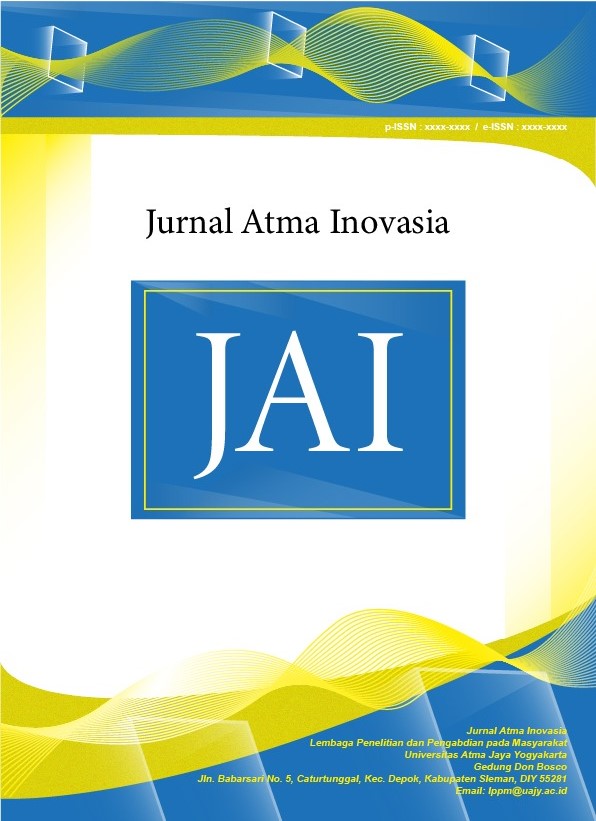Penataan Akustik GKJ Gondokusuman Kota Yogyakarta
DOI:
https://doi.org/10.24002/jai.v4i6.9860Keywords:
akustik, Gereja Kristen Jawa, simulasiAbstract
Gereja Kristen Jawa Gondokusuman diresmikan tanggal 11 Desember 1930 di lingkungan yang tenang. Saat ini, lingkungan gereja menjadi padat dan dilewati jalan dengan lalu lintas padat. Kebisingan lingkungan dan perubahan pujian telah menyebabkan akustik gereja saat ini perlu ditata ulang agar nyaman. Program CATT 8 digunakan untuk memperoleh desain akustik yang lebih baik melalui metode simulasi. Hasil simulasi menemukan bahwa penambahan penyerap bunyi dapat menurunkan waktu dengung dari 3 detik ke 1,5 detik serta mengurangi kebisingan di dalam ruang sebesar 10 dB. Penerapan hasil simulasi akan membuat akustik GKJ Gondokusuman lebih nyaman untuk berbagai bentuk pujian dari paduan suara, band, hingga gamelan.
References
[1] V. Hongisto, D. Oliva, and J. Keränen, “Subjective and objective rating of airborne sound insulation - living sounds,” Acta Acust. united with Acust., 2014.
[2] S. Girón, L. Álvarez-Morales, and T. Zamarreño, “Church acoustics: A state-of-the-art review after several decades of research,” Journal of Sound and Vibration. 2017.
[3] L. Álvarez-Morales, S. Girón, M. Galindo, and T. Zamarreño, “Acoustic environment of Andalusian cathedrals,” Build. Environ., 2016.
[4] F. Martellotta, E. Cirillo, A. Carbonari, and P. Ricciardi, “Guidelines for acoustical measurements in churches,” Appl. Acoust., 2009.
[5] D. Queiroz de Sant’Ana and P. H. Trombetta Zannin, “Acoustic evaluation of a contemporary church based on in situ measurements of reverberation time, definition, and computer-predicted speech transmission index,” Build. Environ., 2011.
[6] S. Ansay and P. H. T. Zannin, “Evaluation of the Acoustic Environment in a Protestant Church Based on Measurements of Acoustic Descriptors,” J. Build. Constr. Plan. Res., 2016.
[7] F. Martellotta, “The just noticeable difference of center time and clarity index in large reverberant spaces,” J. Acoust. Soc. Am., 2010.
[8] E. Badino, L. Shtrepi, and A. Astolfi, “Acoustic Performance-Based Design: A Brief Overview of the Opportunities and Limits in Current Practice,” Acoustics. 2020.
[9] E. Cirillo and F. Martellotta, “Acoustics of apulian-romanesque churches: Correlations between architectural and acoustic parameters,” Build. Acoust., 2003.
[10] T. J. Cox and P. D’Antonio, Acoustic Absorbers and Diffusers Theory, Design and Application, Third Edition. 2016.
[11] L. Shtrepi, A. Astolfi, G. D’Antonio, and M. Guski, “Objective and perceptual evaluation of distance-dependent scattered sound effects in a small variable-acoustics hall,” J. Acoust. Soc. Am., 2016.
[12] J. P. Arenas and M. J. Crocker, “Recent trends in porous sound-absorbing materials,” Sound Vib., 2010.
[13] L. Álvarez-Morales, T. Zamarreño, S. Girón, and M. Galindo, “A methodology for the study of the acoustic environment of Catholic cathedrals: Application to the Cathedral of Malaga,” Build. Environ., 2014.
[14] M. Vorländer, “Computer simulations in room acoustics: Concepts and uncertainties,” J. Acoust. Soc. Am., 2013.
[15] B. N. J. Postma and B. F. G. Katz, “Perceptive and objective evaluation of calibrated room acoustic simulation auralizations,” J. Acoust. Soc. Am., 2016.
[16] M. Long, Architectural Acoustics: Second Edition. 2014.
[17] M. D. Egan, Architecture Acoustics. 2007.
Downloads
Published
Issue
Section
License
Copyright (c) 2024 Prasasto Satwiko, Sugesti Retno Yanti, Nimas Sekarlangit, Christopher Kevin Kurniawan

This work is licensed under a Creative Commons Attribution-ShareAlike 4.0 International License.










